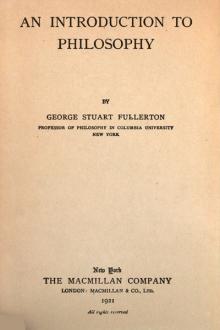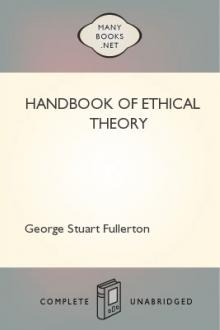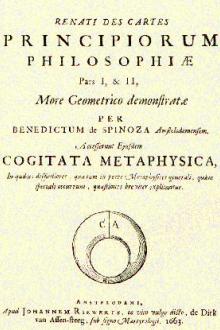An Introduction to Philosophy by George Stuart Fullerton (bookreader TXT) 📖

- Author: George Stuart Fullerton
- Performer: -
Book online «An Introduction to Philosophy by George Stuart Fullerton (bookreader TXT) 📖». Author George Stuart Fullerton
This thing for which so many different visual experiences may serve as signs is the thing revealed in experiences of touch. When we ask: In what direction is the tree? How far away is the tree? How big is the tree? we are always referring to the tree revealed in touch. It is nonsense to say that what we see is far away, if by what we see we mean the visual experience itself. As soon as we move we lose that visual experience and get another, and to recover the one we lost we must go back where we were before. When we say we see a tree at a distance, we must mean, then, that we know from certain visual experiences which we have that by moving a certain distance we will be able to touch a tree. And what does it mean to move a certain distance? In the last analysis it means to us to have a certain quantity of movement sensations.
Thus the real world of things, for which experiences of sight serve as signs, is a world revealed in experiences of touch and movement, and when we speak of real positions, distances, and magnitudes, we are always referring to this world. But this is a world revealed in our experience, and it does not seem a hopeless task to discover what may properly be called real and what should be described as merely apparent, when both the real and the apparent are open to our inspection.
Can we not find in this analysis a satisfactory explanation of the plain man's claim that under certain circumstances he sees the tree as it is and under others he does not? What he is really asserting is that one visual experience gives him better information regarding the real thing, the touch thing, than does another.
But what shall we say of his claim that the tree is really green, and only looks blue under certain circumstances? Is it not just as true that the tree only looks green under certain circumstances? Is color any part of the touch thing? Is it ever more than a sign of the touch thing? How can one color be more real than another?
Now, we may hold to Berkeley's analysis and maintain that, in general, the real world, as contrasted with the apparent, means to us the world that is revealed in experiences of touch and movement; and yet we may admit that the word "real" is sometimes used in rather different senses.
It does not seem absurd for a woman to Say: This piece of silk really is yellow; it only looks white under this light. We all admit that a white house may look pink under the rays of the setting sun, and we never call it a pink house. We have seen that it is not unnatural to say: That tree is really green; it is only its distance that makes it look blue.
When one reflects upon these uses of the word "real," one recognizes the fact that, among all the experiences in which things are revealed to us, certain experiences impress us as being more prominent or important or serviceable than certain others, and they come to be called real. Things are not commonly seen by artificial light; the sun is not always setting; the tree looks green when it is seen most satisfactorily. In each case, the real color of the thing is the color that it has under circumstances that strike us as normal or as important. We cannot say that we always regard as most real that aspect under which we most commonly perceive things, for if a more unusual experience is more serviceable and really gives us more information about the thing, we give the preference to that. Thus we look with the naked eye at a moving speck on the table before us, and we are unable to distinguish its parts. We place a microscope over the speck and perceive an insect with all its members. The second experience is the more unusual one, but would not every one say: Now we perceive the thing as it is?
21. ULTIMATE REAL THINGS.—Let us turn away from the senses of the word "real," which recognize one color or taste or odor as more real than another, and come back to the real world of things presented in sensations of touch. All other classes of sensations may be regarded as related to this as the series of visual experiences above mentioned was related to the one tree which was spoken of as revealed in them all, the touch tree of which they gave information.
Can we say that this world is always to be regarded as reality and never as appearance? We have already seen (section 8) that science does not regard as anything more than appearance the real things which seem to be directly presented in our experience.
This pen that I hold in my hand seems, as I pass my fingers over it, to be continuously extended. It does not appear to present an alternation of filled spaces and empty spaces. I am told that it is composed of molecules in rapid motion and at considerable distances from one another. I am further told that each molecule is composed of atoms, and is, in its turn, not a continuous thing, but, so to speak, a group of little things.
If I accept this doctrine, as it seems I must, am I not forced to conclude that the reality which is given in my experience, the reality with which I have contrasted appearances and to which I have referred them, is, after all, itself only an appearance? The touch things which I have hitherto regarded as the real things that make up the external world, the touch things for which all my visual experiences have served as signs, are, then, not themselves real external things, but only the appearances under which real external things, themselves imperceptible, manifest themselves to me.
It seems, then, that I do not directly perceive any real thing, or, at least, anything that can be regarded as more than an appearance. What, then, is the external world? What are things really like? Can we give any true account of them, or are we forced to say with the skeptics that we only know how things seem to us, and must abandon the attempt to tell what they are really like?
Now, before one sets out to answer a question it is well to find out whether it is a sensible question to ask and a sensible question to try to answer. He who asks: Where is the middle of an infinite line? When did all time begin? Where is space as a whole? does not deserve a serious answer to his questions. And it is well to remember that he who asks: What is the external world like? must keep his question a significant one, if he is to retain his right to look for an answer at all. He has manifestly no right to ask us: How does the external world look when no one is looking? How do things feel when no one feels them? How shall I think of things, not as I think of them, but as they are?
If we are to give an account of the external world at all, it must evidently be an account of the external world; i.e. it must be given in terms of our experience of things. The only legitimate problem is to give a true account instead of a false one, to distinguish between what only appears and is not real and what both appears and is real.
Bearing this in mind, let us come back to the plain man's experience of the world. He certainly seems to himself to perceive a real world of things, and he constantly distinguishes, in a way very serviceable to himself, between the merely apparent and the real. There is, of course, a sense in which every experience is real; it is, at least, an experience; but when he contrasts real and apparent he means something more than this. Experiences are not relegated to this class or to that merely at random, but the final decision is the outcome of a long experience of the differences which characterize different individual experiences and is an expression of the relations which are observed to hold between them. Certain experiences are accepted as signs, and certain others come to take the more dignified position of thing signified; the mind rests in them and regards them as the real.
We have seen above that the world of real things in which the plain man finds himself is a world of objects revealed in experiences of touch. When he asks regarding anything: How far away is it? How big is it? In what direction is it? it is always the touch thing that interests him. What is given to the other senses is only a sign of this.
We have also seen (section 8) that the world of atoms and molecules of which the man of science tells us is nothing more than a further development of the world of the plain man. The real things with which science concerns itself are, after all, only minute touch things, conceived just as are the things with which the plain man is familiar. They exist in space and move about in space, as the things about us are perceived to exist in space and move about in space. They have size and position, and are separated by distances. We do not perceive them, it is true; but we conceive them after the analogy of the things that we do perceive, and it is not inconceivable that, if our senses were vastly more acute, we might perceive them directly.
Now, when we conclude that the things directly perceptible to the sense of touch are to be regarded as appearances, as signs of the presence of these minuter things, do we draw such a conclusion arbitrarily? By no means. The distinction between appearance and reality is drawn here just as it is drawn in the world of our common everyday experiences. The great majority of the touch things about us we are not actually touching at any given moment. We only see the things, i.e. we have certain signs of their presence. None the less we believe that the things exist all the time. And in the same way the man of science does not doubt the existence of the real things of which he speaks; he perceives their signs. That certain experiences are to be taken as signs of such realities he has established by innumerable observations and careful deductions from those observations. To see the full force of his reasonings one must read some work setting forth the history of the atomic theory.
If, then, we ask the question: What is the real external world? it is clear that we cannot answer it satisfactorily without taking into consideration the somewhat shifting senses of the word "real." What is the real external world to the plain man? It is the world of touch things, of objects upon which he can lay his hands. What is the real external world to the man of science? It is the world of atoms and molecules, of minuter touch things that he cannot actually touch, but which he conceives as though he could touch them.
It should be observed that the man of science has no right to deny the real world which is revealed in the experience of the plain man. In all his dealings with the things which interest him in common life, he refers to this world just as the plain man does. He sees a tree and walks towards it, and distinguishes between its real and its apparent color, its real and its apparent size. He talks about seeing things as they are, or not seeing things as they are. These distinctions in his experience of things remain even after he has come to believe in atoms and molecules.
Thus, the touch object, the tree as he feels





Comments (0)